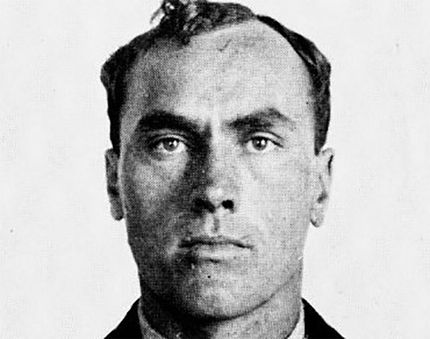Pinched from The Line-Up
Carl Panzram has been called a “one-man crime wave” and described as “too evil to live”. His crime spree spans nearly two decades, even though he was hanged at the age of 38. During that time, he committed arsons, burglaries, and more, and confessed to more than 20 murders and the rape of as many as 1,000 men and boys. His plans for grander crimes—while never realized—would have been right at home coming from the lips of a comic book supervillain. While he was sitting on death row in Leavenworth, he wrote a memoir, which began with a chilling one-sentence summary of his dark deeds, followed by the simple statement, “For all these things I am not in the least bit sorry.”
Panzram was one of the most bizarre killers in American history. He was born in East Grand Forks, Minnesota in 1892, and by 1903 he was in the Minnesota State Training School, a reform school for juvenile offenders. While there, Panzram was beaten and raped repeatedly, in a building that the school’s occupants called “The Painting House.” In 1905, Panzram burned the building to the ground: his first act of arson, but far from his last.
By the age of 15, Carl Panzram had enlisted in the army by lying about his age, although his military career didn’t last long. In fact, he was dishonorably discharged and sentenced to Leavenworth after stealing from a supply closet. William Howard Taft (then Secretary of War, soon to be President of the United States) signed the order sending Panzram to prison. And Carl Panzram was a man to hold a grudge.

When he was released from Leavenworth in 1910, “all the good that may have been in me had been kicked and beaten out”, in Panzram’s own words. Panzram had already engaged in a string of burglaries and arsons prior to his time at Leavenworth—churches were a preferred target. Yet life behind bars sharpened Panzram’s rage to a fine point, and he had grown into a full-size man of six feet and roughly two hundred pounds. He put his massive frame and violent drive to work, preying upon, again in his own words, “the weak, the harmless and the unsuspecting.”
Panzram rode the rails, burglarizing homes, burning churches, and committing multiple rapes and murders. He was regularly arrested by authorities. Yet he soon found himself back on the streets, carrying out a crime wave that tests the limits of believability. Indeed, much of what we know about Panzram’s shocking life of crime comes from the man himself, and is therefore difficult (if not impossible) to corroborate fully.
In August 1920, Panzram found his way to New Haven, Connecticut, where, in the course of robbing houses, he found himself in the home of by-then-former President William Howard Taft. From that house, he stole a fair bit of money, and also Taft’s personal pistol, which, Panzram claimed, was later used in quite a few murders. With the money he had gotten, Panzram bought a yacht and, according to his later confessions, began to lure sailors onto it with the promise of work, only to rape and murder them out at sea, dumping their bodies overboard.
Eventually, Panzram made his way to Angola, where he continued his trail of murder, rape, and other crimes. He claims to have killed six men there and fed them to crocodiles. It was also in Angola that, according to Panzram’s confessions, he raped and killed the first of at least three young boys.
Read the full feature HERE!






